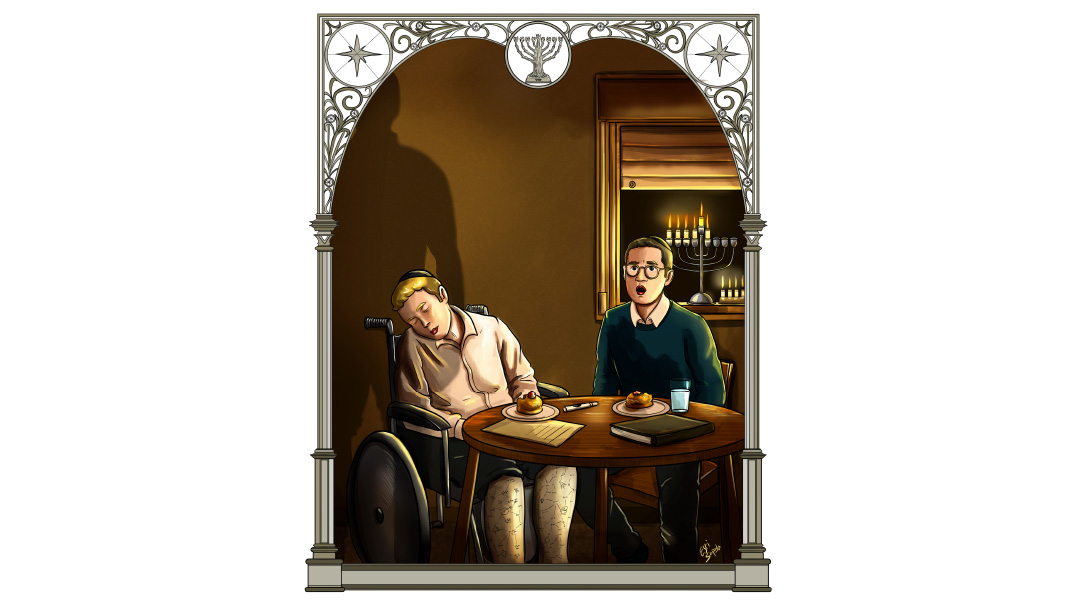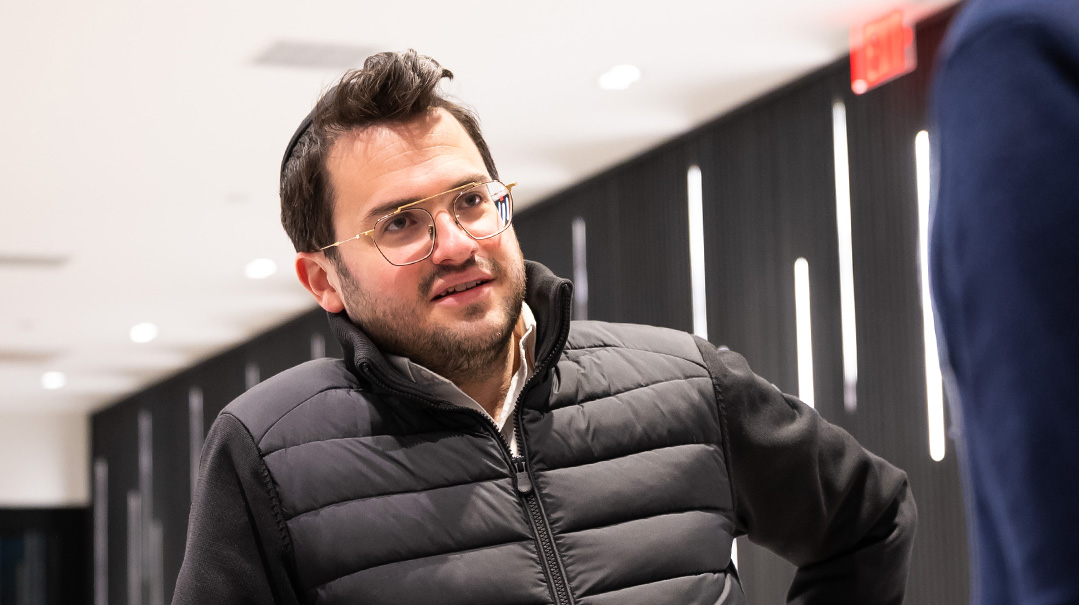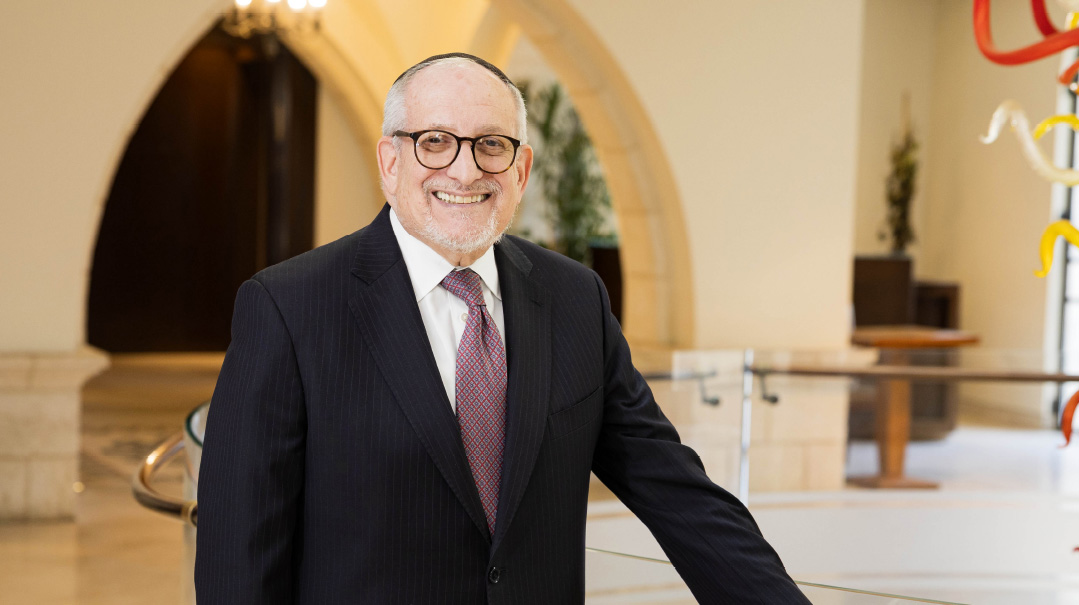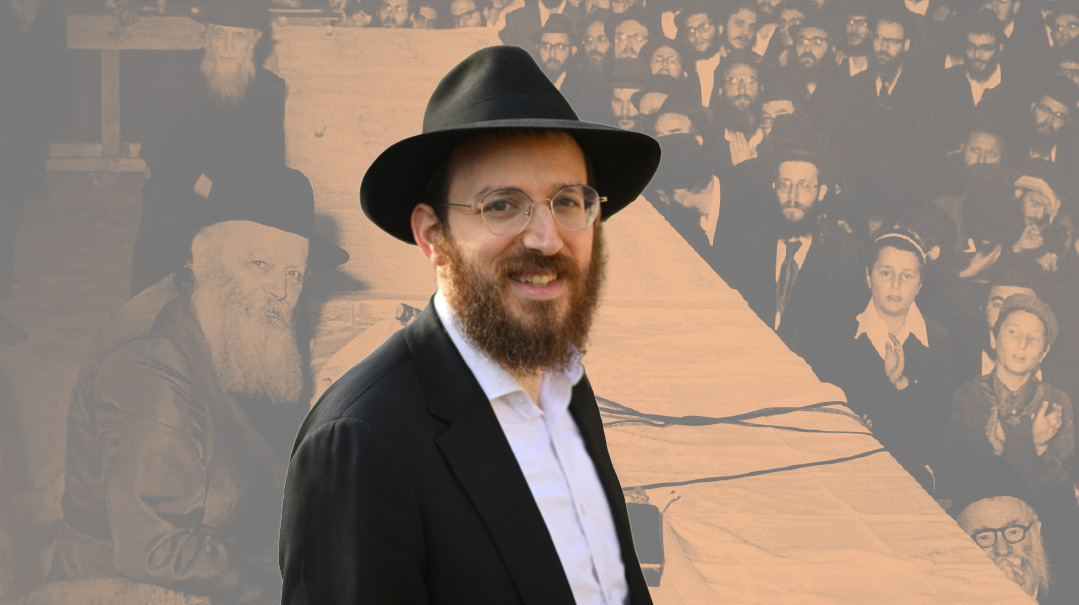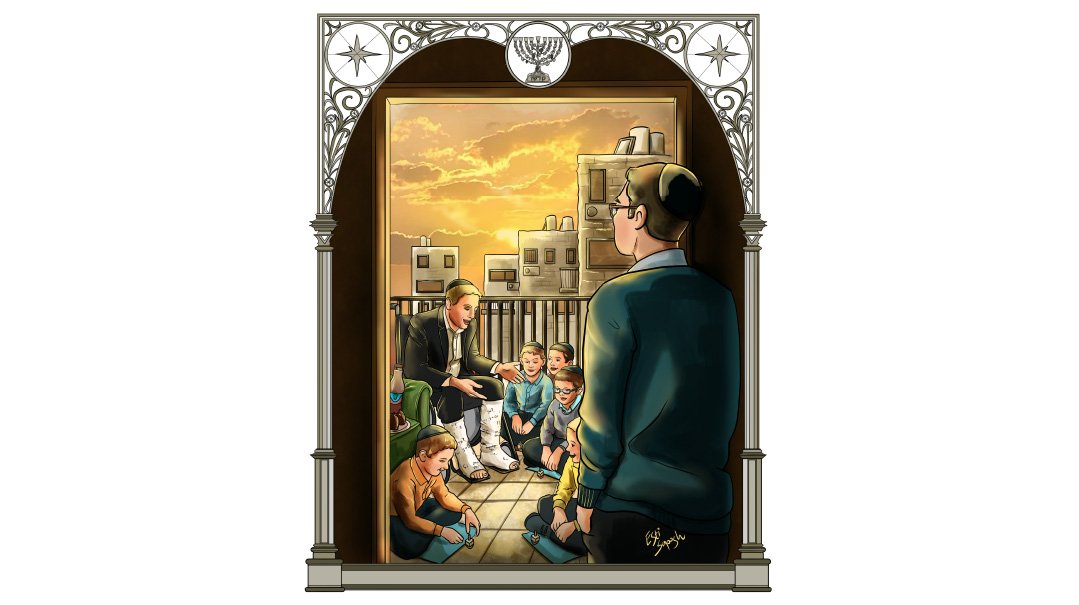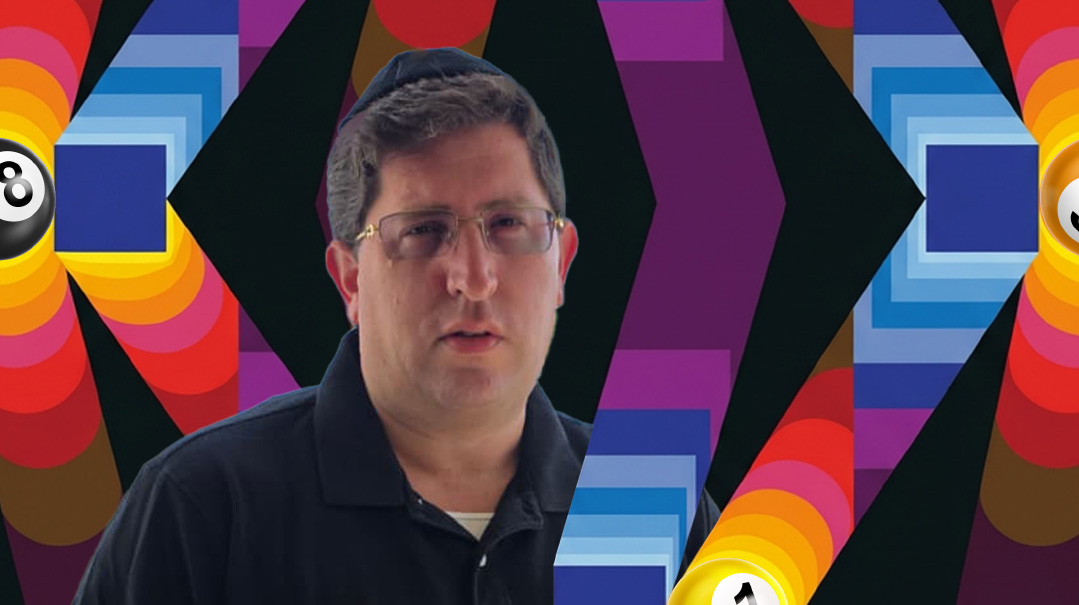At a Fast Clip
| April 1, 2025From used cars to ice cream bars, Efraim Feder’s videos clip the competition
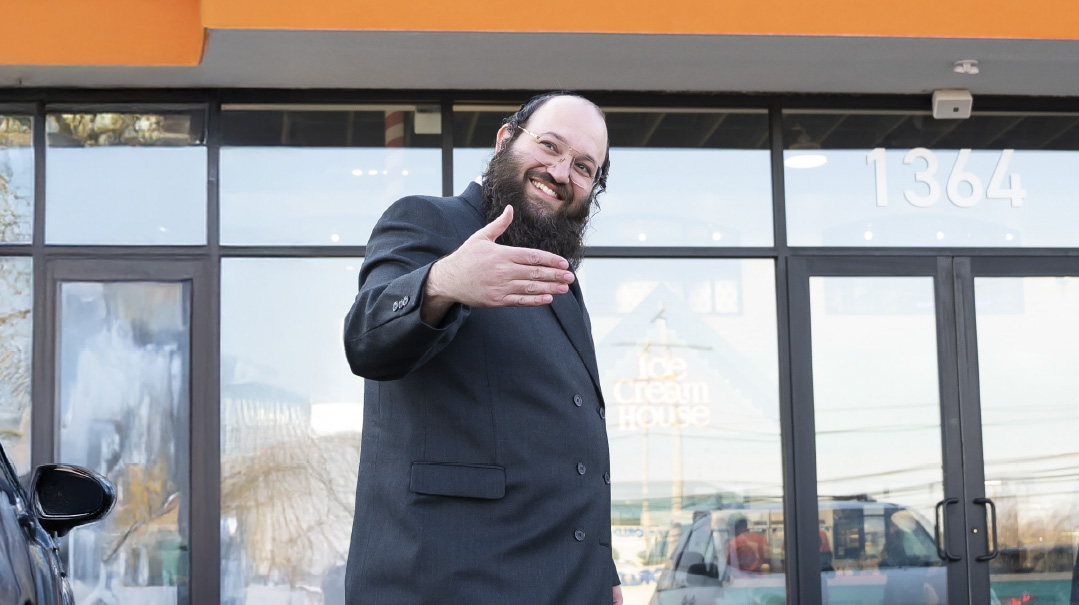
Photos: Avi Gass
When Efraim Feder began selling houses in Lakewood, he realized that buyers wanted a feel for the community before signing, and so he began aiming his camera around his own neighborhood. After his first content video featured the pizza store down the block, he realized he’d found a niche. Over 700 videos later, businesses realized it, too: One short clip can send hundreds of customers to a new business, even before the paint dries
Ice Cream House stands like a pastel-colored palace against the fading evening sky. Its teal-trimmed roof and glowing orange signage give it the playful charm of a life-sized Playmobil set. Spanning 10,000 square feet, this brand-new Lakewood café is one of the largest chalav Yisrael ice cream establishments in the world. Through the large glass storefront, bright colors and whimsical shapes hint at an experience beyond just dessert.
Inside, a candy-colored dream unfolds. A towering, two-story ice cream counter, trimmed in teal and topped with a quaint, house-like facade, dominates the space. Touchscreen kiosks in the foreground offer a streamlined ordering experience, while arched seating alcoves in the background showcase cozy nooks. Every detail, from the black-and-white tiled floor to the decorative swirls on the walls, feels almost theatrical. And even before their grand opening, Ice Cream House knows just the man to show all those potential customers what that experience is all about.
Efraim Feder enters the spanking-new edifice with a bounce in his step and an ear-to-ear smile, looking like a kid in, well… an ice cream store. The Belzer chassid with a knack for storytelling and digital engagement has a warm, inviting presence that makes him instantly approachable. He wears a long black rekel, and the woolen tzitzis draped over his shirt are an ever-present reminder of his identity, so his target audience shouldn’t be confused. Feder’s full beard, clear-framed glasses, and neatly-combed peyos give him a look that is both classic and contemporary, much like his promotional content — thoroughly heimish yet effortlessly engaged with the modern world.
Unlike a regular customer, though, Feder isn’t there to place an order. Before anyone can consider stopping him, he’s behind the counter, poking around like a detective on a sugar rush.
“How does this work? Where does the pizza come out?”
The questions roll out like a like a four-year-old with a grogger — high-energy, persistent, and impossible to ignore.
Feder is no passive observer. As one of the most influential content creators in the frum world, he’s built a loyal following on several platforms by offering an insider’s look at new businesses, community events, and hidden gems across in the Tristate area and beyond. His videos — usually filmed with nothing more than his phone and a pair of clip-on mics — feel spontaneous, but they’re powered by an instinctive understanding of what draws people in. Whether it’s a massive chassidish glamping site upstate [“glamping” is the new word for “glamorous camping,” or luxurious tent-living with all the modern amenities], a newly renovated seforim store, or an under-the-radar eatery, Feder approaches every location — often before they actually open — with infectious enthusiasm and rapid-fire curiosity.
His formula is pretty basic: Get there first, ask the right questions, and show viewers what they didn’t even know they wanted to see. And the results speak for themselves — one short clip can send hundreds of customers flocking to a store overnight, even when the paint is still wet.
Into the Customer’s Head
Feder’s day job in real estate is actually what propelled him to get his feet wet in content creation. It was 2020, and while selling houses in Lakewood and its environs, he noticed that everyone in the industry was posting generic property listings: Spacious 6-bedroom, 4-bathroom colonial in prime Lakewood location! Features large eat-in kitchen with granite countertops, formal dining room, and finished basement with separate entrance. Walking distance to multiple shuls, yeshivos and shopping.
But potential buyers from Brooklyn weren’t necessarily interested in square footage or interior decor, Feder realized. What they wanted was a feel for the Lakewood lifestyle — the schools, the shuls, the local stores. They wanted to know what life was really like in this fast-growing frum community before taking the plunge and signing on a house.
Figuring that content videos would be an effective way to woo potential homebuyers, Feder started by aiming his camera on his own neighborhood of Harmony Park. In his first video, he set out to solve a local curiosity: Why were there two establishments named Village Pizza on opposite sides of the same small shopping plaza? (Turns out, they were in the middle of transitioning to their new, larger establishment a few stores down and decided to keep the original store operational throughout.) Before long, Feder’s spirited recorded investigation evolved into a new focus — video promos for business — and he was covering new stores, housing developments, and communal events, capturing not just places, but the people and stories behind them. It was a shift from selling homes to selling a sense of place, and it worked. Viewers didn’t just watch; they engaged.
To date, he’s created over 720 videos, on just about every topic and business that would interest the frum consumer, from housing developments and plumbers to fancy restaurants and pizza stores to silver polish and sweatless beketshes.
The impressive thing about Feder’s influence is that isn’t just about clicks — he drives real foot traffic. Business owners have taken note of the sudden influx of customers after his video goes live.
“Some businesses are afraid to call me before opening because they don’t want to get overwhelmed,” Feder says. “It used to be that new stores had to advertise for weeks. Now, one video, and the place is packed.”
“I don’t think people realize how popular Feder’s videos are,” Yitzchok Fischer, founder of WeForm Interiors and Ice Cream House’s designer, tell me on the side. He’s here to show Feder around for the store’s promo video, and as we follow Feder, Fischer tells me about a friend in a very niche industry who was recently featured in one of Feder’s clips. After it went live, he got more than 200 calls.
One thing that makes Feder’s videos so appealing is their seemingly effortless simplicity. There’s no overproduction, no scripted stiffness — just a guy walking around, excitedly describing an establishment as if to a good friend. His content, a combination of Yiddish, Yinglish, and yeshivish, has a spontaneous, home-movie-like feel.
As he moves about, he’s constantly thinking, What makes the biggest visual impact for the first shot? Is the dialogue coming across as too scripted or too spontaneous? Am I capturing the sheer size of it all? He doesn’t script, but he doesn’t quite wing it either. Instead, he records himself several times, plays them back right away, and decides which version lands best. The rest? It’s all in his head.
His ability to structure content on the fly, to distill complexity into snappy, engaging soundbites, is what makes watching his videos feel like you’re there with him.
And yet, Feder tells me, he’s always thinking, refining, tweaking in his head. How can I say this in fewer words? How do I make this clearer? How do I keep people watching?
His pacing — he allots no longer than 20 seconds for each question and answer — keeps the energy high, the engagement tight, and the final video free of fluff.
Feder’s questions aren’t just about understanding the store: They’re shaping the video itself. His rapid-fire inquiries don’t just probe — they produce.
“Why is this display here?” he asks Fischer, pointing at the centerpiece. Then he turns a sharp gaze in the direction of the booths. “Why is that seating there? And how come there’s nothing between this and that?” he adds, gesticulating between the centerpiece and the booths.
If there’s a design choice that doesn’t make immediate sense, Feder wants to know why. (If he doesn’t like the answer, he’ll offer a better one.)
Check Out the Back
His setup is unassuming: No flashy production crew, no heavy-duty gear, no tripod, no external lighting, not even a notepad.
“I try to keep my videos as authentic and as natural as possible, which is why I choose to do it all myself,” Feder explains. “The only thing I have someone helping out with is writing the descriptions with the client, following up on payments, sending invoices, that type of thing.”
He says his favorite kind of work is touring a factory. He mentions a tour of ArtScroll’s publishing operations in Rahway, New Jersey, and another behind-the-scenes exposition at Zeibart’s Chocolates nearby, where viewers can practically smell the caramel squares passing through a coating pool of molten chocolate on the conveyor belt.
“I always try to interview the owner or someone involved in the project because people want to get the behind-the-scenes feel,” he says. “When I go into restaurants, I like to go into the back, see how the chefs are preparing the food, and take the viewers with me.”
Hilly Fisher, owner of The Lamppost restaurant a short drive outside Lakewood, recalls taking Feder on a tour of his kitchen.
“He doesn’t eat, he doesn’t even show his face on camera,” Fisher says. “The way he explained it to me was, ‘I’m showing off your business. It’s not about me eating or me enjoying myself.’ ”
For Feder, the focus is always on the place, the product and the people behind it, but the nature of his work means that some jobs are easier than others.
“Sometimes it’s complicated, like what content can I squeeze out from a plumber? From an electrician? From a handyman? These are tough projects, and I tell my clients that if they want the video to have an effect, we need to make it interesting.”
He did that with a plumber by following him around from site to site, first to a shul to see how people were clogging up the mikveh, and then down to basements to see pumps clogged with wipes.
“They have a special camera that goes through pipes and it shows what’s going on in real time,” Feder relates. “People were very interested to see how it works from the inside.”
Another time, he had an electrician show him a new type of Shabbos lamp he invented. People like hearing from the guy who created an item, he explains, or the guy who opened the store, which is why Feder prefers interviewing someone at that level, even if he isn’t the most articulate.
“Some people don’t want to be interviewed. They’ll send me a product in the mail and tell me to post a review about it. But when an owner talks about his own product, people are more likely to believe in it.”
Most of his clients are in Lakewood, where it seems another retail store, supermarket, restaurant, you-name-it, opens weekly, and viewers from around the world watch the videos, “going nuts as they watch it unfold.”
Feder attributes the positive feedback to help from Above, and his genuine desire to help others grow their businesses.
“I’ll come to a place and I don’t know where to start,” he says. “It’s pretty boring, and the people don’t know how to talk. How can I make this an exciting, enthusiastic clip? So I say a kapitel Tehillim and things start to move, ideas start popping up, suddenly in walks the perfect person to interview. I always try to figure out what the chiddush of the particular store or company is, and every time the Eibeshter helps me out.”
Feder still sees himself as he was when he first started — just a guy with a camera and a curiosity for what makes businesses tick. But to the business world, he’s a marketing powerhouse, a name that can drive real traffic and boost the bottom line. And while he insists he’s not a celebrity, the recognition he gets everywhere tells a different story.
“I’ve had big company owners — and I mean really big ones — personally call me to come down, which is a huge honor for me,” he says. “I’ve also been invited by major organizations like Bonei Olam, ATime, RCCS, and others to cover their events.”
This past January, a group of askanim invited him as a special guest to the Trump inauguration.
“It was an incredible opportunity, but between all my work, I just couldn’t find the time to fly down.”
Behind the American Dream
While today Efraim Feder is a household name in Lakewood and its environs, he himself grew up in Boro Park and began raising a family there. He was living in a one-bedroom apartment with three kids, and when the Belzer Rebbe began encouraging his chassidim to join a new kehillah in Lakewood, the Feders decided to take the plunge. In 2015, they moved to the fledgling Harmony Park community (his parents have joined them there since).
Feder first pivoted from real estate to content writing in 2020. His first major breakthrough was when he filmed American Dream Mall’s new DreamWorks Water Park. The massive entertainment complex was still under wraps, but thanks to Menachem Melamed, the founder of the popular WhatsApp newsfeed Kol Haolam and a friend of Feder’s with a connection with one of the mall’s managers, he was given an inside look before the official opening.
“I was the first to introduce American Dream not just to the frum world, but to the entire world,” Feder recalls of his first video, a preview of what would become one of the country’s most popular destinations.
Feder took his audience into the DreamWorks Water Park, offering an early glimpse of what would soon become one of the largest indoor water parks in the world. In the video, he walks through the massive space, analyzing various attractions, pointing out towering water slides, wave pools, and lazy rivers — all still in limbo between construction and operation. Beyond the water park, Feder explores other key attractions within the mall, including a kosher food establishment, a mini-golf course, and an ice hockey rink, giving viewers a sense of the diverse entertainment options available.
While most of the mall was still closed at the time of filming, one feature was already operational — the indoor artificial skiing course, complete with a functioning ski lift. Feder highlights this unexpected attraction, emphasizing its unique appeal, particularly for those in the Jewish community looking for family-friendly entertainment options in a climate-controlled setting.
When the almost-six-minute-long video was complete, he posted it to several platforms, where it garnered thousands of views. It spread fast, even beyond the Jewish community, solidifying Feder’s reputation as a digital insider who could bring people to places they hadn’t yet seen. Ever since, his ability to gain early access to high-profile locations speaks to the growing trust in his platform.
Unplanned
Feder’s content creation involves a constant balancing act between his side hustle and his full-time real estate career. His reputation as a high-impact advertising force means businesses frequently reach out for paid promotions, and with several online videos a week, and sometimes several a day on WhatsApp, that demand comes with new challenges: keeping his content feeling fresh, authentic, and organic, and maintaining the trust of his audience while delivering results for the businesses relying on him.
Aside from grand openings and paid advertisements, Feder also posts real estate content and interesting videos and images as he encounters them. He can barely go shopping without finding something to feature.
“The more advertisements I take, the more content I have to create — I always try to keep a balance,” Feder says, explaining how he alternates ads with content. “I don’t like to post 16 ads in a row, so that forces me to constantly create. Sometimes I feel like I have too many ads, and I literally run out into the street to free up my creative side, trying to break my mind — what content can I create now?”
But surprisingly, Feder says the pressure actually fuels his momentum, perhaps because he sees Hashem’s Hand in it all.
“My whole career was never a thought-out plan,” he says. “People who knew me as a young kid, a young bochur, a yungerman, wouldn’t believe what this has turned into. I feel like I’m a walking miracle. None of this was planned, everything came directly from Hashem — and He always sends me interesting stuff that I can talk about.”
Old Is New
While the Ice Cream House shoot showcases something new and trendy, when I shadow Feder the next day in Lakewood’s Judaica Plaza, I get to see him doing something different.
“Today’s shoot is a very interesting one,” he says. “I’m not going to show a cool new store — Judaica Plaza is probably one of the oldest and biggest Judaica stores in the world.”
Instead, Feder’s video will be about transformation — a landmark of the community adapting to meet 2025 while still maintaining its legacy. The chiddush, Feder explains, is that the store remained open the entire year they did construction, completely renovating it section by section.
“Attention customers!” owner Avraham Levine announces. “For the next five minutes we have the famous Efraim Feder here taking some videos. Anyone who doesn’t want to be in the video should put their face down in a sefer or go to the side of the store.”
Business proceeds as usual, even as Feder works his way through the newly remodeled space, capturing both the old and the new — the seforim-lined walls that had stood for decades, now accented by sleek, contemporary design — as he narrates the changes for his thousands of followers.
In a way, the shoot is an apt metaphor for what Feder himself does. He takes something familiar — a local shop, a community event, a neighborhood staple — and presents it in a way that will make people feel it’s a thing or experience that they must have. He builds narratives, crafts experiences, and gives his audience a fresh perspective on the places they think they already know.
Like when he helps himself to a steaming bowl of toameha cholent and kishke while checking out Camp Shabbat, the first heimish glamping experience, viewers who haven’t yet signed up for an all-frills no-frills weekend outside of Woodridge surely feel that they’ve missed a great vacation opportunity. But if mosquitos aren’t your thing, Feder shows you how to camp out in the comfort of your dining room with a Buffet Box of do-it-yourself s’mores (complete with tongs and a mini burner).
Friends Everywhere
We’re now heading to Bun, a fleishig restaurant. Within two minutes, Feder is already in the kitchen — no invitation, no hesitation. His effortless confidence makes it seem as if he belongs there, moving with such ease that no one questions his presence.
“I could never do that,” the photographer whispers in quiet amazement.
It doesn’t take long for Feder to find something that fascinates him — the motion-activated sauce dispensers offering ten different condiments. His excitement is immediate.
“How exactly do these sensors work? How do they get refilled when they’re empty? And did you notice the buffalo sauce and honey mustard labels got switched?”
Although he’s been here before, Feder is still noticing new details. He has questions about the wall’s design, the seating in the simchah hall, and the intricate pipe system that snakes from the sauce bar to the kitchen like an elaborate, industrialized monkey bar.
Later, we arrive at Dips, which specializes — unsurprisingly — in dips. While the store itself isn’t large, its selection is, extending well beyond dips to include meats, cold cuts, fresh challah, and even a popcorn machine. Feder examines the display with interest, suggesting new products they should carry — a second type of yapchik, a different kind of liver.
As we walk out, people on the street recognize him, and store owners greet him like an old friend. They know that whenever Feder walks in as a customer, a little free exposure isn’t far behind. Over time, the line between content creator and community member has blurred, and by now, these owners aren’t just features in Feder’s videos — they’re part of his circle of friends.
Take Two
Whether it’s a sprawling megamall or a shop opening its doors for the first time, Feder has a way of zeroing in on a unique feature that turns any location into a must-visit destination. At American Dream it was a ski lift, and back at the now-open Ice Cream House, it’s a staircase.
The sweeping staircase leads to an upper-level seating area, its curved orange-and-white railings adorned with colorful spheres and playful geometric rings, pops of green, pink, blue, and yellow embedded into the balusters. It all adds a kind of kinetic energy to the scene. Warm ceiling lights cast a soft glow on the sleek gray steps, making the entire staircase feel like a pathway to something special — and another opportunity for Feder to ask, “Nu, so how does this work?”
Feder shifts his focus to the three clusters of kiosks, which take up nearly a third of the main floor. He raises an eyebrow.
“This entire section is just for ordering? No seating at all on this side?”
“Exactly,” Fischer says with a nod, explaining that they wanted to separate the noisier, high-traffic ordering section from the seating, so that sit-down customers can enjoy their food in a more relaxed environment.
Right in the middle of the store stands a fantastical display that looks like it was inspired by a board game designed by Uncle Moishy after too many slushies. A trio of towering poles, striped like oversized candy canes in red, yellow, and black, extends from the floor to the ceiling, giving the impression of a life-size confectionary jungle gym. Beneath these whimsical pillars sits an arrangement of geometric shapes — large circular arches in pastel blue, gold, and peach, as well as oversized spheres that resemble gumballs scattered across the floor. The entire structure serves as both a visual centerpiece and a playful backdrop.
Once Feder spends the first 20 minutes absorbing, asking a seemingly endless stream of questions, touching everything as he mentally pieces together how he envisions his video unfolding, he shifts gears.
Now it’s actually showtime — and Fischer, the designer behind Ice Cream House, is up. While the viewer sees what looks like a spontaneous clip, there’s usually a more complex backstory. First, Feder feeds Fischer his lines to describe the store’s most noticeable feature (“Talk about how long and how unique the display is, don’t forget to mention the size of the place”) and delivers his signature mix of encouragement and critique after Fischer’s first take.
“This description is perfect,” Feder says kindly. He pauses, before adding — with impeccable comedic timing — “if you’re trying to have the viewers asleep in under sixty seconds.”
Next, he turns his attention — and lens — on the staircase.
“Explain to us what’s up with all these ballies on the staircase,” Feder prompts.
Fischer talks about how they symbolize toppings and sprinkles, adding to the dessert-inspired theme. He then gestures toward the back wall, pointing out how its design mimics melting ice cream.
But Feder isn’t satisfied just yet.
“Again.”
A second take. A third. A fourth. A fifth. Each time, he resets the scene, walking back down the steps while directing Fischer — positioned on the second floor — to walk toward him on cue. Every take is a refinement, an adjustment, a pursuit of the perfect shot.
“My biggest challenge,” Feder confesses, “is when I enter such a big place with so many options. Like, where do I start?”
The answer is pretty clear: Everywhere.
(Originally featured in Mishpacha, Issue 1056)
Oops! We could not locate your form.

